To build a successful B2B storefront, adopt proven DTC tactics – craft a strong brand story, deliver a personalized buying experience, and optimize your Ecommerce site for seamless usability. Use digital marketing channels like email, SMS, and social media to engage buyers, provide rich product content, automate key processes for efficiency, and continuously act on customer feedback to strengthen loyalty.
This guide unpacks how to apply these DTC strategies to your B2B Ecommerce store, supported by the latest industry data, practical insights, and technology recommendations that empower you to grow confidently in today’s dynamic marketplace.
Introduction: Understanding the Convergence of B2B and DTC Ecommerce
The lines between B2B and DTC Ecommerce are blurring faster than ever. What was once a clear divide between business transactions and consumer shopping has evolved into a shared expectation: seamless, personalized, and frictionless buying experiences regardless of whether you’re purchasing for a company or yourself.
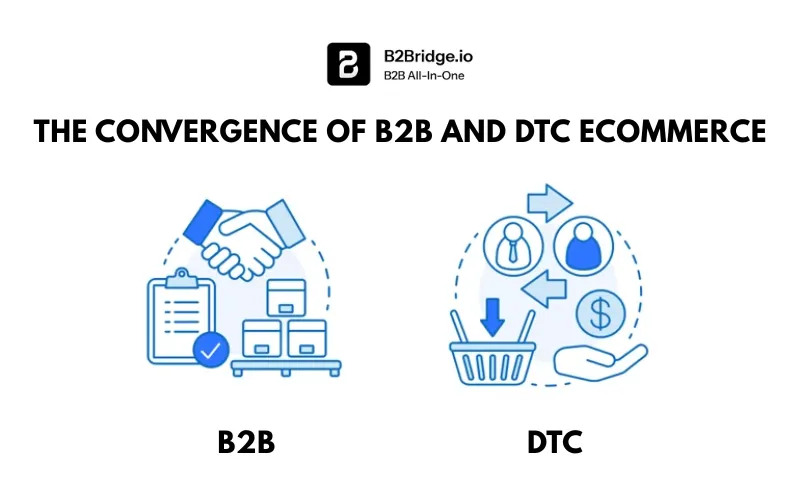
Applying DTC tactics to B2B doesn’t mean treating businesses like individual consumers. It means creating the same level of agility, personalization, and ease that modern buyers have come to expect from their favorite consumer brands. Think Amazon-style convenience meets professional purchasing power.
The data tells a compelling story. Millennials now make up 73% of B2B buyers, and they expect speed, transparency, and user-friendly digital experiences. This demographic shift is driving fundamental changes in how B2B commerce operates. These buyers grew up with instant information and seamless digital interactions – they won’t settle for clunky ordering systems and opaque pricing when making business purchases.
The numbers back this transformation: the global B2B Ecommerce market is valued at $32.1 trillion in 2025 and is projected to grow to $62.2 trillion by 2030. More telling is that 69% of B2B customers expect an Amazon-like buying experience, including personalized product recommendations, tailored pricing, and an intuitive interface.

Meanwhile, wholesale pricing strategies are evolving in 2025. AI is helping distributors optimize inventory, increase personalization, and improve forecasting and pricing, while dynamic pricing adjusts wholesale prices in real-time based on current market demand. The traditional static pricing model is giving way to flexible, personalized approaches that respond to market conditions and individual customer relationships.
The convergence of B2B and DTC isn’t just a trend – it’s a necessity for staying competitive in today’s digital-first economy.
>> Read more: B2B vs B2C Ecommerce: Key Differences and Trends
Key Differences Between B2B and DTC Models to Consider
Before diving into tactics, it’s crucial to understand what makes B2B fundamentally different from DTC, so you can adapt strategies rather than simply copy them.
Customer Profiles and Buying Motivations
DTC customers make emotional, personal purchase decisions. They’re buying for themselves, influenced by brand story, lifestyle fit, and immediate needs.
B2B buyers make rational, data-driven decisions. They’re purchasing for organizations, evaluating ROI, compliance requirements, and long-term supplier relationships. Multiple stakeholders often weigh in on decisions.
Order Sizes and Frequency Patterns
DTC transactions typically involve single items or small quantities, with sporadic purchasing patterns driven by individual need or desire.
B2B orders involve bulk quantities with predictable reorder cycles. A retailer might order 500 units monthly, while a DTC customer buys one item every few months.
Pricing Structures and Transparency
DTC pricing is straightforward: fixed retail prices visible to everyone, with occasional promotions or discount codes.
B2B pricing is complex: negotiated wholesale rates, volume discounts, customer-specific pricing tiers, payment terms (Net 30, 60, 90), and relationship-based adjustments. Different customers see different prices based on their agreements.
Sales Funnel Complexity
DTC funnels are relatively simple: awareness → consideration → purchase. The journey can happen in minutes.
B2B funnels are lengthy and complex: research → evaluation → approval → negotiation → purchase. Multiple decision-makers, budget cycles, and approval processes can extend the timeline to weeks or months.
Understanding these differences ensures you adapt DTC tactics thoughtfully rather than implementing strategies that won’t work in a B2B context.
Why Applying a DTC Lens is a Competitive Advantage
The B2B companies winning in 2025 aren’t choosing between traditional approaches and modern tactics – they’re strategically combining both.
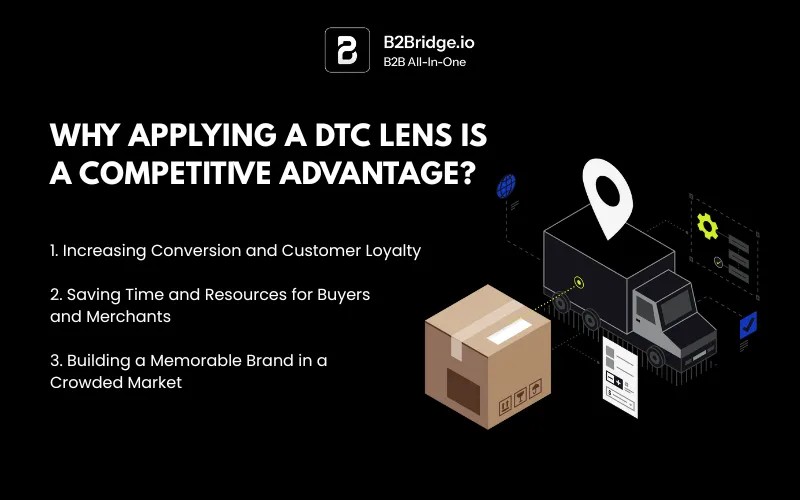
Increasing Conversion and Customer Loyalty
Self-directed interactions now surpass human interactions in B2B buying, with two-thirds of B2B buyers ready to make purchases exceeding $50,000 without direct engagement with a salesperson. When you provide DTC-style convenience – intuitive navigation, clear product information, easy reordering – you remove friction that causes abandoned carts and lost opportunities.
Customers who have positive digital experiences return. They become loyal not just because of your products, but because working with you is effortless.
Saving Time and Resources for Buyers and Merchants
Traditional B2B sales require extensive manual work: phone calls, email exchanges, quote generation, order processing. DTC-inspired self-service features let buyers place orders anytime without waiting for sales reps, while automation handles routine tasks.
This efficiency benefits both sides. Buyers get instant access to information and can place orders on their schedule. Merchants reduce labor costs and free their sales teams to focus on relationship-building and strategic accounts rather than processing routine reorders.
Building a Memorable Brand in a Crowded Market
Most B2B companies treat their online presence as a catalog – functional but forgettable. DTC brands have mastered storytelling, creating emotional connections even when selling commodities.
When you apply this approach to B2B, you stand out. You’re not just another supplier; you’re a brand that resonates. The average B2B buyer consumes 13 pieces of content during their purchasing journey, and compelling brand storytelling makes those touchpoints memorable.
Financial Benefits That Impact Your Bottom Line
The cost savings are substantial. Reduced sales team hours on routine orders, fewer errors from manual data entry, lower customer service burden as buyers find answers themselves – these efficiencies directly improve profit margins.
Meanwhile, better customer experiences increase average order values and purchase frequency. When ordering is easy, customers buy more and buy more often.
Key DTC Strategies to Apply to Your B2B Model
Now let’s get tactical. Here are the core DTC strategies that translate powerfully to B2B Ecommerce.
Focus on Brand-Building and Storytelling
B2B buyers aren’t robots. They’re people making decisions, and people connect with stories.
Rather than presenting dry spec sheets and technical data, tell the story behind your brand. What problem are you solving? What values drive your company? Why should buyers care beyond the product specifications?
Back up your brand promises with undeniable proof. Use compact proof blocks highlighting certifications, performance metrics, awards, and customer testimonials. These elements build trust while reinforcing your narrative.
Think about your online presence as a tool for buyer market research. When purchasing managers evaluate suppliers, they’re not just comparing prices – they’re assessing whether your brand feels reliable, innovative, and aligned with their values. Strong storytelling helps buyers justify their choice internally, giving them confidence when presenting to stakeholders.
Simplify the Customer Journey
Complexity is the enemy of conversion in B2B Ecommerce.
Tailor the logged-in experience to show each customer only relevant products at their negotiated pricing. If a retailer only buys kitchen supplies, don’t clutter their view with unrelated categories. Personalized catalogs make navigation intuitive and speed up the buying process.
Speed up ordering with quick order forms and spreadsheet uploads. Many B2B buyers know exactly what they need and have SKU lists ready. B2Bridge’s quick-order functionality lets them paste SKU numbers and quantities in bulk, completing orders in seconds rather than clicking through product pages individually.
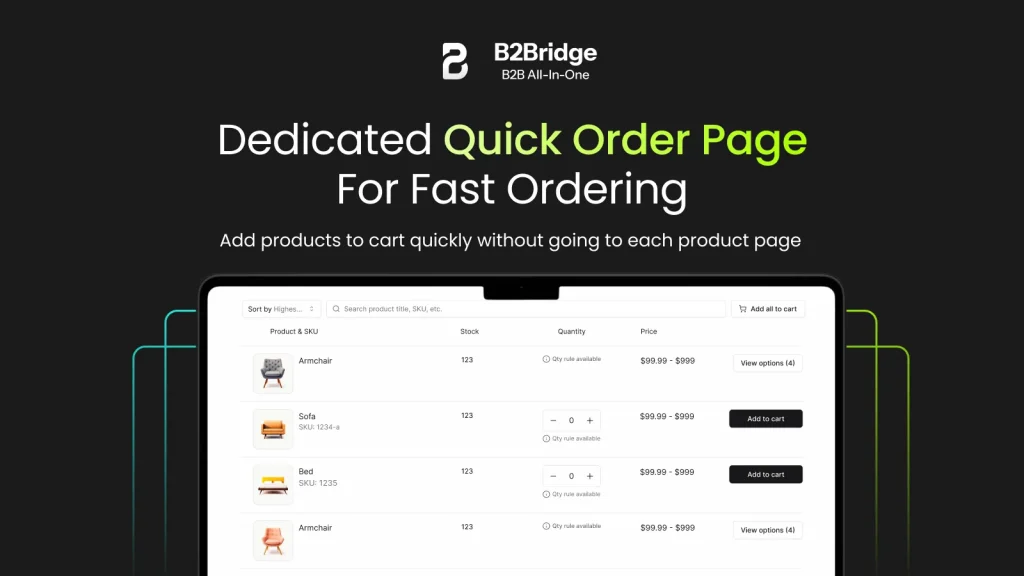
Streamline approvals with simple authorization rules. Set order limits where purchases under certain amounts auto-approve, while larger orders route to managers. This prevents bottlenecks while maintaining necessary controls.
Provide a simple account page where buyers track shipments, access invoices, and reorder with one click. The easier you make it to do business with you, the more business you’ll get.
>> See B2Bridge’s Pricing Plan
Leverage First-Party Data for Personalization
Just 20% of B2B sellers said they feel prepared for the future, often because they’re not utilizing data effectively.
The gold mine is in unifying information from your storefront, ERP, and CRM to create a single customer view. B2Bridge’s Public API enables this integration, connecting your Ecommerce platform with backend systems so customer data flows seamlessly.
With unified data, you can deliver personalized experiences that B2B buyers value. Research shows business buyers are twice as likely to share data when it leads to better personalization.
Create dynamic catalogs that adapt to purchase history. If a customer regularly orders specific products, feature those prominently. Use intelligent cross-sells based on buying patterns – if they purchase coffee, suggest complementary items like filters or sweeteners.
Dynamic pricing based on customer relationships, order volume, and negotiated terms becomes automated rather than manual, reducing errors while ensuring customers always see their correct pricing.
Implementing a DTC-Style Experience with the Right Features
Strategy is worthless without execution. Here’s how to implement these approaches with specific features and functionality.
Offer Deep Customization and Personalization
Generic experiences won’t cut it in modern B2B Ecommerce.
Customized product catalogs let you show different product selections to different customer segments. Distributors see wholesale options; end users see retail products. Each customer sees what’s relevant to them. B2Bridge makes this seamless, allowing you to create multiple catalog views from a single product database without duplicating content.
Customer-specific pricing rules automatically display negotiated rates, volume discounts, and special terms. B2Bridge enables granular control over pricing at the customer or customer group level, so you maintain complex pricing structures without manual intervention.
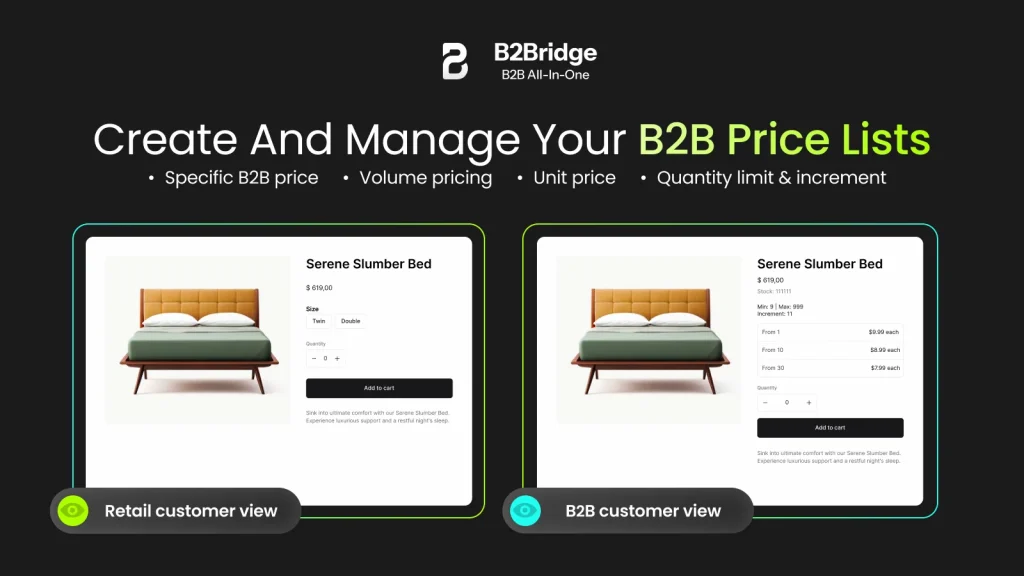
Quantity rules enforce minimum or maximum order quantities per product or category. Set case quantities or bulk requirements that align with your distribution model. B2Bridge lets you configure these rules at the product or category level, ensuring compliance with your wholesale terms automatically.
Branding customizations ensure consistent experience across channels. If you operate both DTC and B2B on the same platform, customize the look, feel, and messaging for each audience while managing everything from one system.
Multi-currency and multi-language options enable global expansion. B2Bridge supports international B2B operations, letting you serve customers in their preferred currency and language without managing separate storefronts.
Reviews and curated recommendations build trust. Even B2B buyers want social proof. Display testimonials, case studies, and product reviews that help buyers feel confident in their decisions.
Empower Buyers with Self-Serve and Automation
80% of B2B sales interactions between suppliers and buyers will occur in online channels by 2025, making self-service capabilities essential.
24/7 ordering lets customers place orders whenever convenient for them, not just during your business hours. International clients appreciate asynchronous ordering that works across time zones.
Self-managed account access allows customers to control their user permissions, add team members, and manage who can view pricing or place orders. This reduces your administrative burden while giving customers autonomy. B2Bridge’s account management system empowers your customers to handle their own team structure without requiring support tickets or calls to your team.
Merchant automation features reduce manual work. Vaulted credit cards let you securely store payment methods for faster checkout and automatic billing. Payment reminders for Net 30, 45, or 60-day terms reduce late payments and improve cash flow. B2Bridge offers these net payment terms, automates these payment workflows, and enables automatic charging for approved customers.
Buyer self-serve features make repeat business effortless. Easy reordering from purchase history, editable account information, and the ability to manage multiple shipping addresses or warehouses.
Provide Flexibility in Payments and Ordering
Modern B2B buyers expect payment flexibility that matches their business operations.
Personalized checkout experiences include options like requesting quotes online. Some purchases need negotiation; integrating quote requests into the buying flow keeps customers in your ecosystem rather than forcing them to email or call.
Flexible payment options accommodate different business needs. Some customers want to pay immediately via credit card; others need payment terms. Authorize merchants to charge vaulted credit cards for automatic billing, or display negotiated payment terms (Net 30, 60, 90) at checkout so buyers know their options. B2Bridge supports the full spectrum of B2B payment scenarios, from instant credit card processing to complex payment terms with automatic invoicing and reminders.
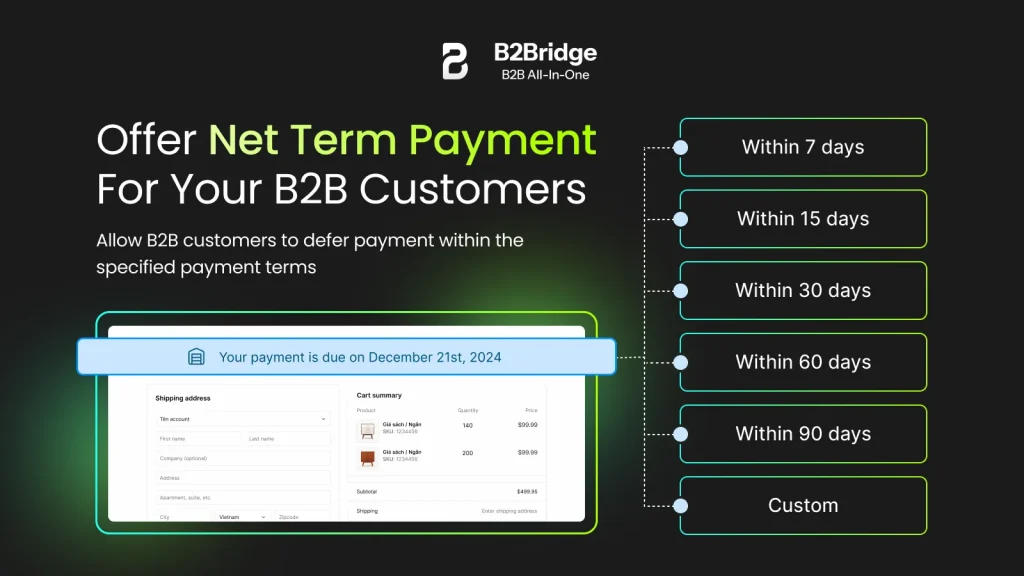
Complex logistics support is crucial for B2B. Customers need to customize shipping addresses for various stores or warehouses, specify delivery dates, and add order notes with special instructions. B2Bridge handles these requirements, ensuring your platform supports real-world B2B workflows.
Case Studies and Data-Driven Insights
Theory is valuable, but results prove the concept. Here’s what happens when B2B brands embrace DTC tactics.
Dermalogica: DTC Tactics Drive Wholesale Growth
Dermalogica, the professional skincare brand, operates both DTC and B2B channels serving beauty professionals and salons. When they applied DTC personalization tactics to their wholesale platform, they saw increased purchase frequency and improved conversion rates.
By creating tailored experiences for professional buyers – featuring relevant products, professional-size options, and streamlined reordering for salon owners – they made wholesale purchasing as convenient as consumer shopping. The result: more frequent orders and higher customer satisfaction among their professional network.
Laird Superfood: Self-Service Slashes Labor Costs
Laird Superfood implemented a self-serve B2B platform to reduce the manual work involved in wholesale operations. The impact was immediate: lowered labor costs from fewer hours spent processing orders manually, plus boosted wholesale revenue as retailers found it easier to reorder.
When friction disappears, sales increase. Retailers who previously might have delayed orders because contacting a sales rep was inconvenient could now place orders instantly whenever they noticed inventory running low.
TileCloud: Simplification Drives Sign-ups and Order Size
TileCloud simplified their trade customer experience with a streamlined B2B platform that made it easy for contractors and designers to browse, get pricing, and place orders. The results: significant growth in trade customer signups and increased average order sizes.
By removing complexity and creating an intuitive experience, they attracted more professional buyers and made it effortless to add items to orders, naturally increasing cart values.
Key Lessons and Replicable Strategies
These success stories share common threads:
- Personalization matters: Showing relevant products and pricing increases engagement and conversion.
- Self-service sells: Removing dependency on sales reps for routine orders frees both buyers and merchants.
- Simplicity wins: The easier ordering becomes, the more frequently customers buy and the larger their orders grow.
- Unified platforms work: Brands like Brooklinen and Dermalogica prove you can successfully manage both DTC and B2B operations from the same foundation, reducing complexity and costs.
The strategy isn’t to choose between B2B and DTC – it’s to bring the best of DTC to your B2B operations while respecting the unique needs of business buyers.
Ready to Transform Your B2B Storefront?
B2Bridge provides the features you need to bring DTC tactics to your B2B operations:
- Quick-order functionality for faster bulk ordering
- Public API for unified data across your tech stack
- Customized catalogs and pricing for personalized customer experiences
- Multi-currency and multi-language support for global B2B
- Flexible payment terms and secure payment processing
- Complex logistics support for multi-location businesses
Stop treating B2B like it’s still 2015. Your buyers expect more, and B2Bridge helps you deliver the modern experience they demand while maintaining the complexity that B2B requires.
Learn how B2Bridge can transform your B2B storefront →
FAQs of B2B and DTC
B2B (business-to-business) refers to companies selling products or services to other businesses. DTC (direct-to-consumer) means a brand sells directly to customers, bypassing intermediaries like distributors or retailers for more control and higher margins.
DTC (direct-to-consumer) brands sell their own products directly to customers, controlling production, marketing, and sales. B2C (business-to-consumer) includes all businesses selling to consumers, even through third-party retailers or marketplaces like Amazon or Walmart.
B2B sells between businesses, B2C sells from businesses to consumers, C2C (consumer-to-consumer) involves individuals selling to each other (like on eBay), and D2C (direct-to-consumer) is when brands sell their products directly to end customers.
A DTC example is Warby Parker, which designs, manufactures, and sells eyewear directly to customers through its website and stores – bypassing third-party retailers and maintaining full control over brand, pricing, and customer experience.
Shopify itself is neither D2C nor B2C; it’s an eCommerce platform that supports both. Many D2C brands use Shopify to sell directly to customers, while B2C and B2B merchants also use it to run their online stores.
Conclusion
The unified commerce approach reduces lead times and increases conversion rates by providing instant information without draining sales team resources. When you apply DTC tactics thoughtfully to B2B – focusing on personalization, simplification, and data-driven experiences – you create competitive advantages that translate directly to revenue growth.
Looking to process payments more efficiently while providing the personalized B2B and DTC experience modern buyers expect? Explore how B2Bridge combines the best of both worlds in one powerful platform.
Hi, I’m Ha My Phan – an ever-curious digital marketer crafting growth strategies for Shopify apps since 2018. I blend language, logic, and user insight to make things convert. Strategy is my second nature. Learning is my habit. And building things that actually work for people? That’s my favorite kind of win.






